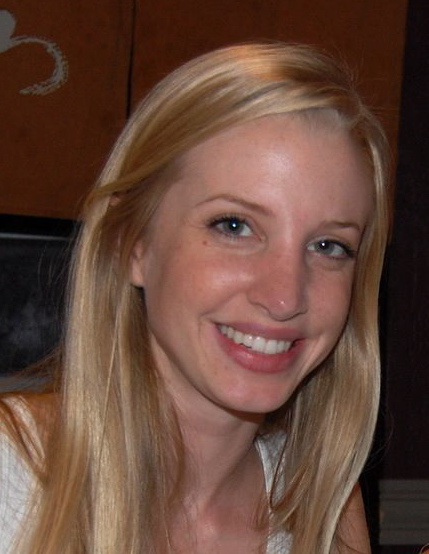
by Brynn Hooton-Kaufman
It started as any good weekend day might. A good cup of coffee, a good book, and a view of the bay. I like to park my car looking out over the tidepools at Asilomar and read, letting the crashing waves add interesting sound effects to whatever scene is playing out in my current novel of choice. Knee deep in Jurassic Park, the waves were bringing to life velociraptors crashing through the forest. Intimidating and terrifying, those velociraptors. But you can’t help but admire them, and the juveniles sound pretty cute. Given the chance, I’d probably take a baby velociraptor for a pet. At least until it started stalking me around the house.
When the sounds of my empty stomach started overpowering the thundering waves, I headed home to make some lunch and get things in order for the coming week. Not two steps into the kitchen my phone buzzed, signaling the arrival of a text message. More often than not, I’d have ignored it, as hunger usually wins out in my ranking of priorities. But as all things happen for a reason, I decided to take a look, and so for once, my phone didn’t get forgotten for hours on end as it usually does.
“hey gray whale calf alive and stranded near monterey dunes colony. TMMC is headed to the scene, we may need ur help! r u available today?”
I had to read the message twice. As much as people might think all marine biologists spend hours on end with dolphins, whales, and other majestic creatures of the sea, learning their mannerisms, capable of identifying any sleek shape that might be surfacing in the bay on a giving day, I hadn’t actually even seen a whaleup close. My closest call was a pod of orcas sighted from the bow of the Point Sur during a class cruise, and I just caught a glimpse of their backs as they headed away. Usually, my most intimate experience with whales was seeing the poof of sea spray that they leave like a footprint above the water, the proof that one of the giants had just taken a great breath before submerging. I really don’t know much about whales. I study seaweed.
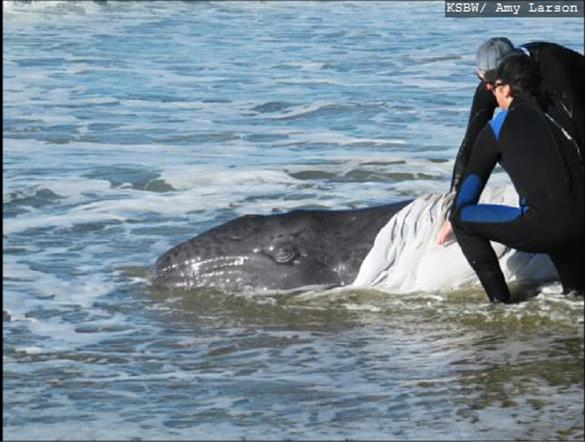
“gray whale calf alive and stranded”
I read it again. This could be the experience of a lifetime. Even with my lack of whale expertise, I could offer my help as an extra set of hands. But then, I had a ton of things I planned to get done today. My thesis draft, though completed and sent off for editing, needed cleaning up in a hundred different ways. I still hadn’t started the presentation for my thesis defense, and creating a 45 minute talk was no small undertaking. I was already behind at work because it was a short holiday week, and I had 50 + people coming for a talk given by one of our grads on Wednesday. A checklist of to-do’s was mounting for my internship, and the technical demands of the tasks were stretching the bounds of my capability. And I didn’t even want to think about the mounting pile of dishes in the sink.
Who was I kidding? Opportunities like this just don’t come around twice. There will always be more dishes.
“Do you want to go out on a baby gray whale stranding?” I asked my partner in crime, better known as my husband Zach, hoping he’d too be willing to drop his holiday Monday plans and join me on an adventure. “Yeah,” he responded, with the mildest undertone of surprise in his voice. I made a mental note that he’d officially become immune to all of the quirkiness that comes from a trajectory in marine science. You’re going tidepooling at three in the morning during the middle of winter because that’s when the low tide hits? Sure, why not. You want to scuba dive in the harbor despite the sludge pouring off the squid boats because you need to collect seaweed for your thesis? Sounds reasonable to me. He was becoming unflappable to my requests. Then I noticed his brows furrowing just a bit. His logical side was kicking in, realizing he should gather more information before blindly following along on my quest. “Where is the whale? How big is it? And what are we going to do?,” he asked.
“All I know is that it’s near Moss Landing,” I replied. The other questions I didn’t have answers to. How big is a baby gray whale, anyway? As big as a horse? Or a van? I had no idea. But I was going to find out, once we made it to the beach. “I’ll try and get more information from Steph, but either way, do you want to go? It’s probably a once in a lifetime kind of thing.” At this point, a thought dawned on me. Up until now, I’d only thought of how exciting it’d be to see a baby whale, and maybe even to touch it. I hadn’t considered what its ultimate fate might be. It must have shown on my face, because Zach tuned in and asked what was wrong. “Well, I hadn’t really thought that the poor guy might die. I’m not really sure how these things usually turn out,” I responded.
“Do you really want to go?”
To answer that question, I didn’t have to think twice.
After a hurried rush around the house, wet suits, towels, binoculars and a camera were thrown into our car and we set off toward Moss Landing. A call to Stephanie Hughes, a friend, fellow grad student, and MLML stranding coordinator, gave us a general idea of where to go, but she too was short on information, and would be heading down as soon as she could. We’d just have to wait until we got there. We pulled up to the gate of the Monterey Dunes Colony, and I punched the call button for the operator. “Can I help you?” she inquired. I began answering, “I’m with Moss Landing Marine Labs, I’m here to – ,” before she cut me off. “Oh I’m so glad you’re here,” she said, relieved, “go on through.” Ma’am, I wish I had your confidence in me. Too bad I study seaweed. And I pulled the car on through the gate.
It took a couple tries to find the whale on the beach. It’s a long beach, and maybe the whale wasn’t as big as I’d thought, since nothing stuck out like a sore thumb. I peered intently through the lenses of my binoculars at groups of people on the beach. No, just a group of kids building a sand castle. A few people beachcombing. Finally, I saw a group of four or five people, and a long shape just mounded above the sand. That would be the whale, I guessed.
We piled back in the car, and headed farther down the beach. We made a trek over the dunes, and finally, we came upon the whale.
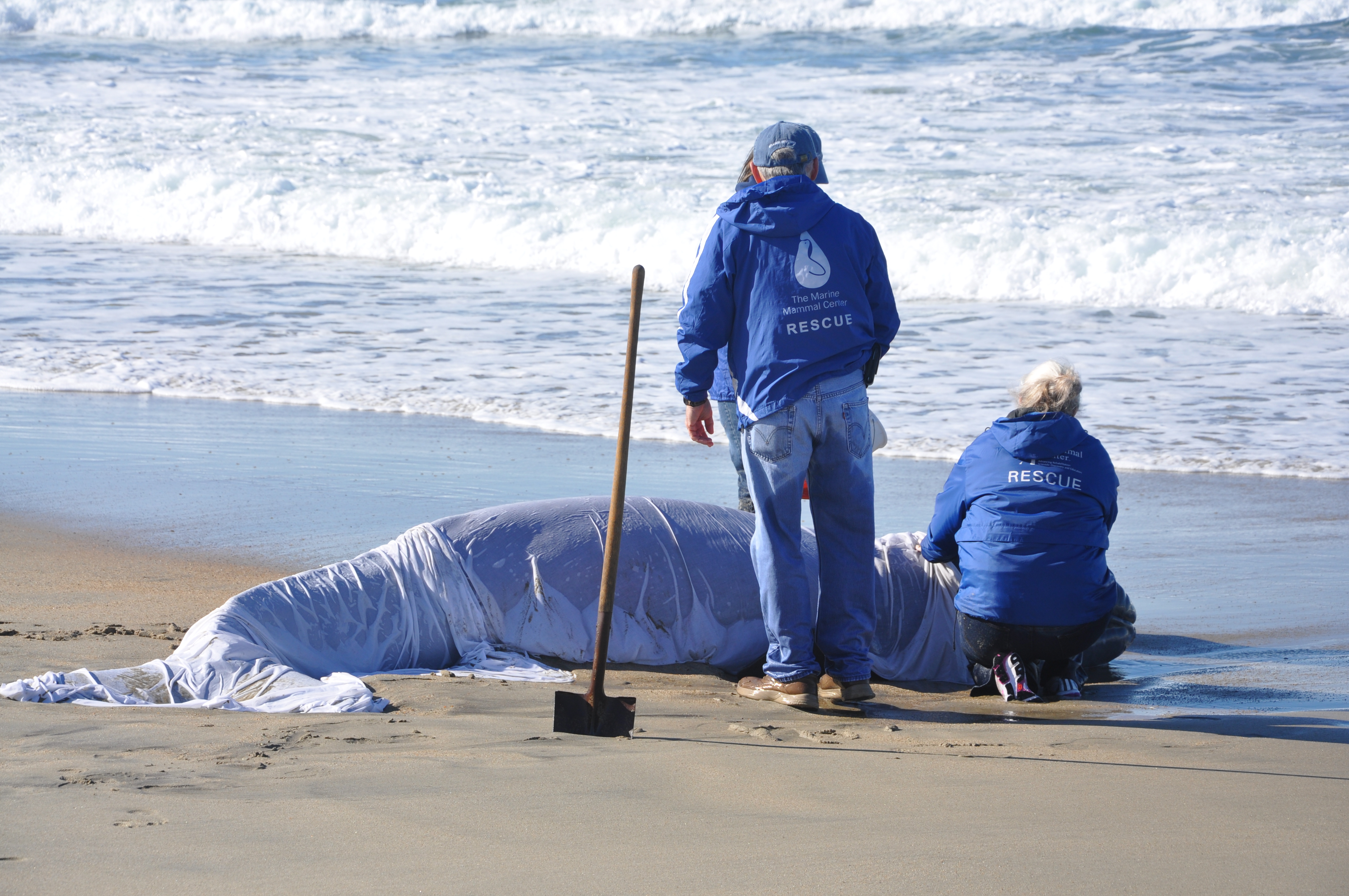
Somewhere over 10 feet long, the whale was a beautiful watercolor pallet of mottled grays. It was beached where the water was just washing up on the sand, and The Marine Mammal Center (TMMC) volunteers were working hard to keep it covered with a sheet, and to keep it upright. There was also what looked to be a high schooler helping, using a small bucket to keep the sheet wet. One volunteer was setting up a perimeter with caution tape to keep any interested folks back.
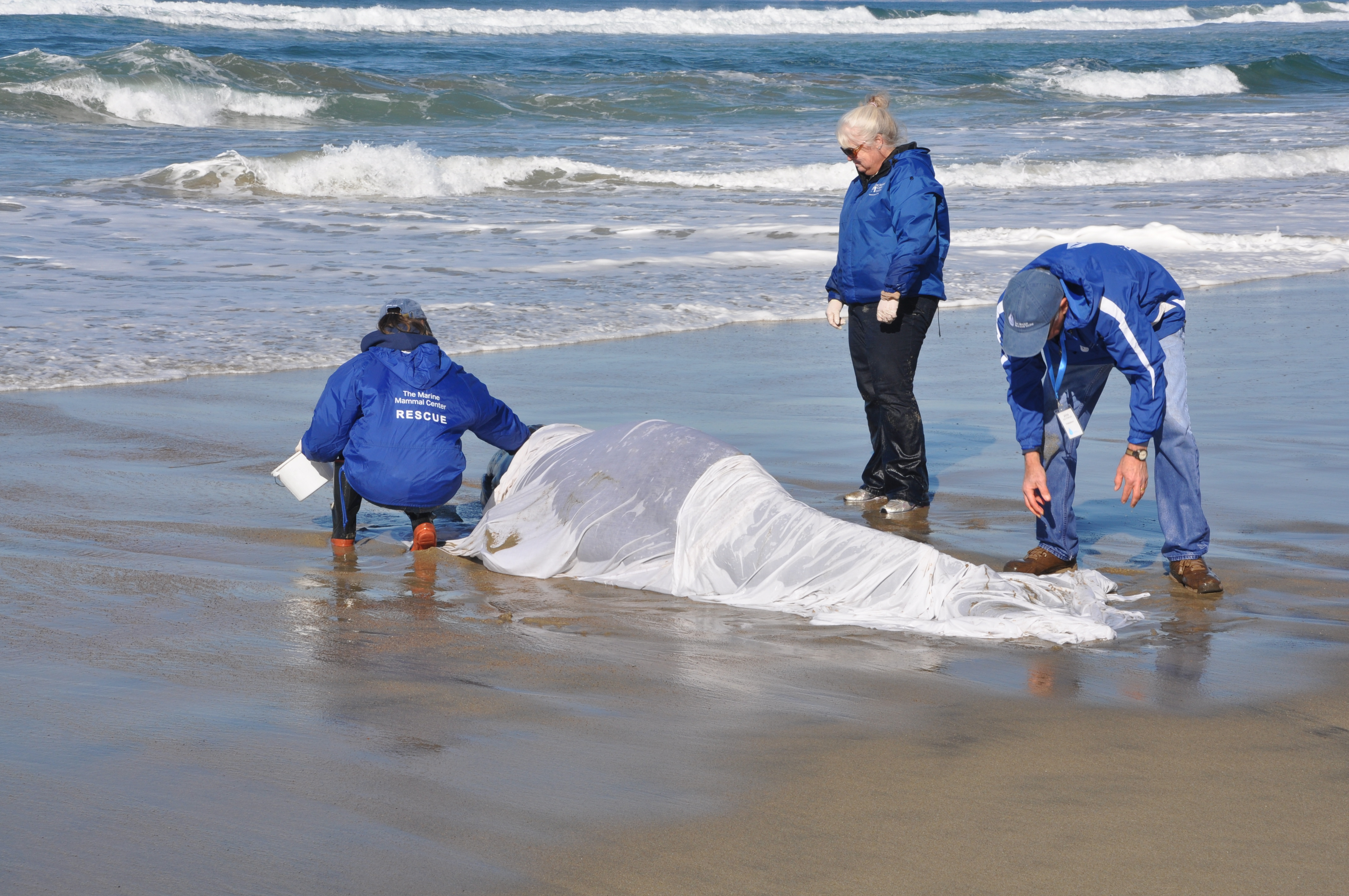
While Zach hung back and took a couple of photos, I walked up and introduced myself. “Hi, I’m Brynn and I’m from Moss Landing Marine Laboratories,” I said, as I shook one of the TMMC volunteer’s hand. “Great,” the volunteer responded, and she launched into a rundown of the whales condition that included terms like “umbi and fetal folds.” As much as I was interested in learning about the whale, I didn’t want to waste her time, since these terms really didn’t mean anything me yet. “I’m sorry,” I interjected, “I was told by Stephanie Hughes, our stranding coordinator, about the whale and I’ve come to help, but I’m really only a second set of hands. I study seaweed.” She immediately found a use for me, and asked me to finish putting up a perimeter to help keep folks back.
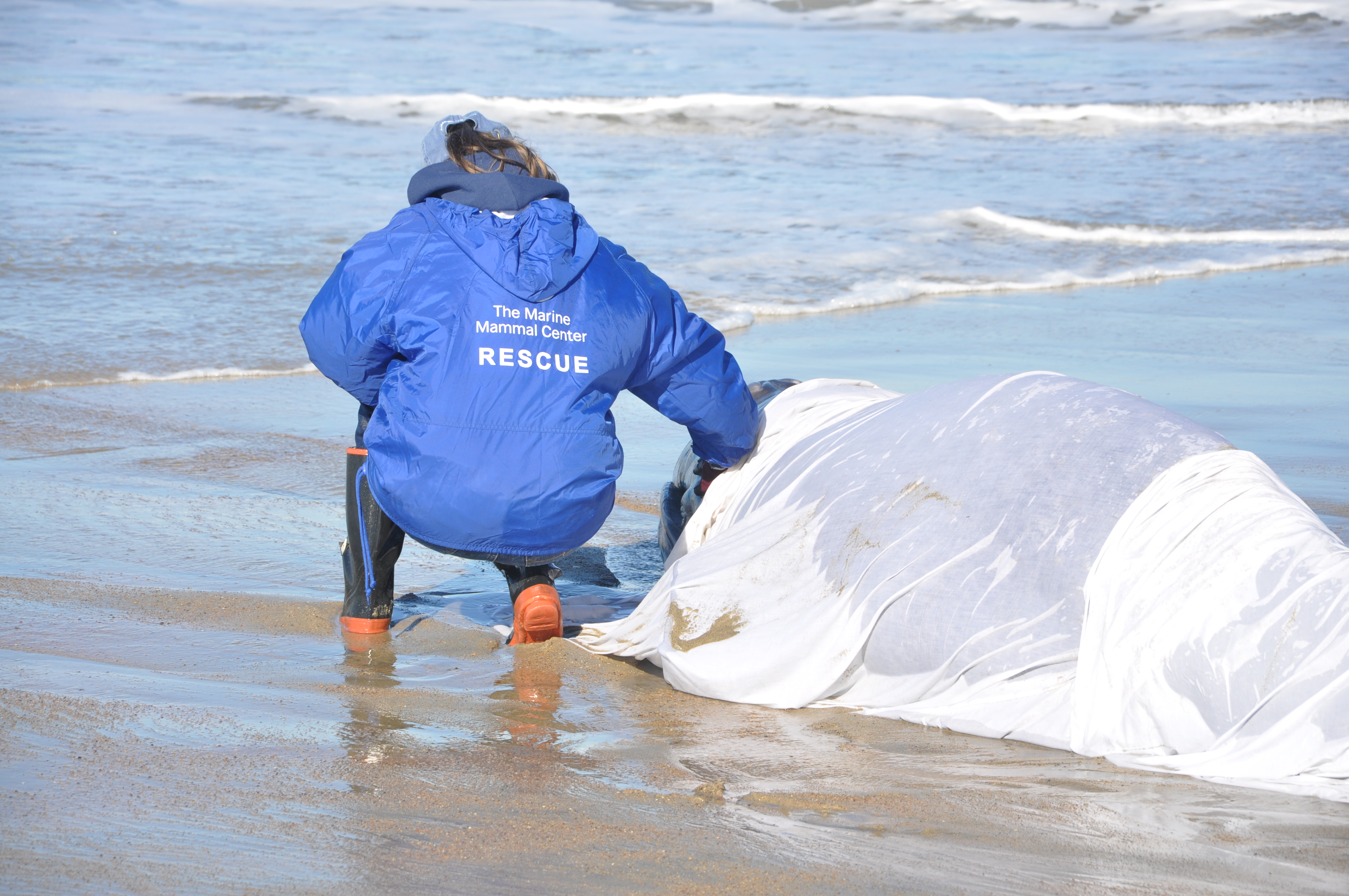
As Zach and I were tying caution tape, it became apparent that the waves were starting the move the whale around, and it was becoming more difficult for the TMMC volunteers to handle the whale with the three of them. It dawned on me that I’d watched the tide fall when I was reading my book at Asilomar earlier in the morning, but at this point it had probably turned, and was coming back in. Handling the whale was only going to become more difficult. Zach seemed to be thinking the same thing, and after exchanging a couple words we decided to go get our wet suits on so we’d be more capable of helping.
After returning with our suits on, we jumped into action. The TMMC crew explained that when out of water, whales’ skin begins to slough off. So, we needed to keep the baby’s skin damp and shaded as much as possible with the sheet they had brought. And of course, the baby also needed to breathe. Keeping it upright so that its blowhole wasn’t covered was certainly a priority. Finally, we needed to protect ourselves from any potential cooties we could catch from the whale. When we were near the blowhole, we needed to wear a mask to make sure we didn’t breathe in any infectious material the whale might be breathing out.
What diseases could an infant whale have, anyway? As I later found out in conversation with some mammal lab MLMLers, we really don’t know. So, better safe than sorry.
I also quickly learned that we needed to make sure to protect ourselves from the strength of the waves coming in, and the baby itself. It’s a hard and fast rule in my book that you never turn your back to the ocean, and this wasn’t an exception. The baby presented a hazard too, since it was similar in weight to a large horse or a cow, and a flap of its fluke could easily cause a serious injury. Or, if a wave rolled it over onto one of us, it could break one of our legs or arms, and trap us underwater. If we were injured, we certainly wouldn’t be able to help the whale. Safety quickly became our number one priority.
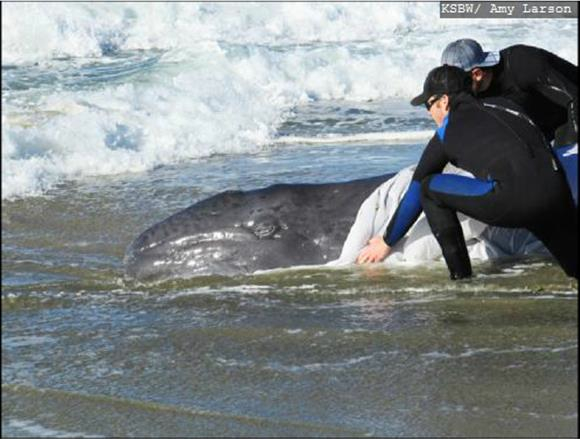
The next couple hours became a blur of freezing cold hands, tired muscles, tumbling waves, and complete awe at spending time with such a majestic animal. While constantly readjusting the protective sheet and trying to brace the giant against the forceful waves, I felt its smooth, warm, slick skin. Sadly, despite our efforts, I saw it sloughing off in many places as the time wore on. Working up near its immense head, I got to look into its dark, soft eyes in the rare moment when it took a look around. As the tide came in and made it more difficult to keep the whale stable and upright, the whale looked more and more weary, and it stopped opening its eyes.
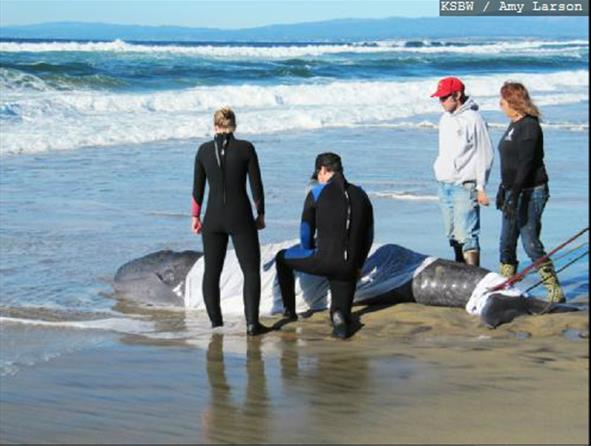
The question nagging at my mind was: what could we do for the whale?
Throughout the day, more TMMC volunteers showed up, as did my fellow MLMLers from the vertebrate ecology lab. Soon, my question was answered. As I learned from my peers, the most humane thing for the baby whale was euthanasia. The mom was nowhere to be found, and we hadn’t seen a spout offshore all day. Without mom, the baby would have no milk and food source, or protection from predators. Chances were, it would be right back on the beach and its suffering would be prolonged. And the truth was, earlier in the day when the whale was a little stronger, there was no way we could have gotten it into the water. It was just too big, and even with more people, we couldn’t have moved it without the help of the tide. The tide wasn’t high enough until much later, when the whale was already weary, weak, and barely responsive.
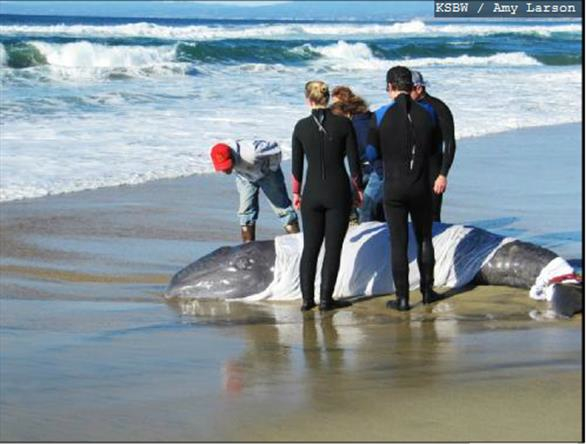
Of course we wouldn’t have known this, either, but the next day a large pod of orcas spent hours in the area, and if the baby had been in the water alone it would have almost certainly become prey.
At some point in the afternoon, the marine mammal veterinarian made it to the scene, and seconded the assessment of the stranding network responders from the MLML vertebrate ecology lab. He did a thorough examination for confirmation, and administered a large does of sedative that would quietly put the whale out of any suffering. It turns out the baby was a female, and he said he thought it was at most a day or two old.
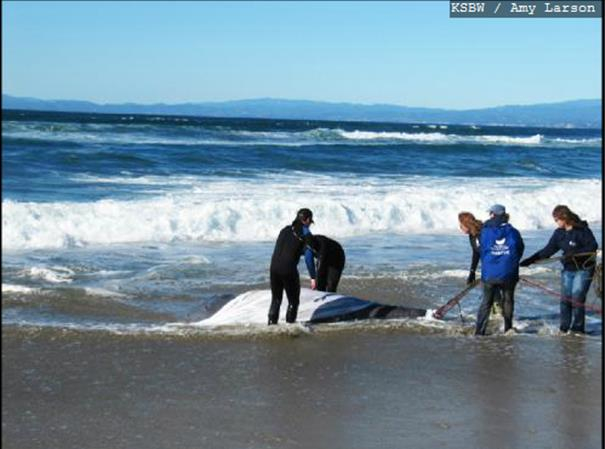
With no more that we could do, Zach and I gathered our belongings and slowly changed back into dry clothes. It wasn’t an easy task with no feeling in our hands and feet. We watched the body of the whale, no longer alive, being moved farther up the beach by winch where it would stay until the following day when the MLML vertebrate ecology students could come back for a necropsy. At least we might learn from this whale’s stranding by assessing its internal condition. On our walk back to the car, we ran into the same high schooler who had been helping at the scene early on, and tagging alongside was what looked like his younger brother, guitar in hand. “How’s it doing,” said the older boy eagerly, with an Australian accent that made me guess they were here on vacation. “Sorry to give you bad news, but it had to be put to sleep” I responded, hoping not to cause too much disappointment. Their moods visibly went from excitement to dismay, but of course, as boys, they tried not to let it show too much. “I was coming to play it a farewell song as it swam away,” said the younger one holding his guitar. I couldn’t help but smile. I explained to the boys what had happened – that the whale had no way of surviving, and that the most humane thing was done – and it was clear they understood and agreed. I also told them that they could come the next day to watch the necropsy, if they wanted, and that the MLML students would probably be able to answer more questions if they had them.
Before we walked on, I made one final suggestion. “You know,” I said, looking down at the boy with the guitar, “you might consider playing the song you had planned, anyway.” “I know the whale isn’t alive anymore, but somehow, it just seems a fitting farewell.”
And so he did.
For news coverage of the baby gray whale stranding, you can visit the following links:
Beached Baby Gray Whale Dies Near Monterey Bay – KCRA
Baby Gray Whale Beached Near Salinas State Beach Dies – KSBW
Baby Whale Washed Ashore in Moss Landing – KION
The newly released film, ‘Big Miracle,’ was based on the real-life rescue of two gray whales trapped by ice in Barrow, Alaska. MLML Director Jim Harvey played a significant role in the 1988 rescue. For his behind-the-scenes story and pictures, and a whale crisis with a happy ending, take a look at this recent blog post: ‘Big Miracle: A Whale of a Story from Operation Breakthrough.”
His story was also featured in The Salinas Californian: http://www.thecalifornian.com/article/20120211/NEWS01/202110317
and the SJSU Today Blog: http://blogs.sjsu.edu/today/2012/moss-landing-marine-labs-interim-director-played-part-in-real-big-miracle/

